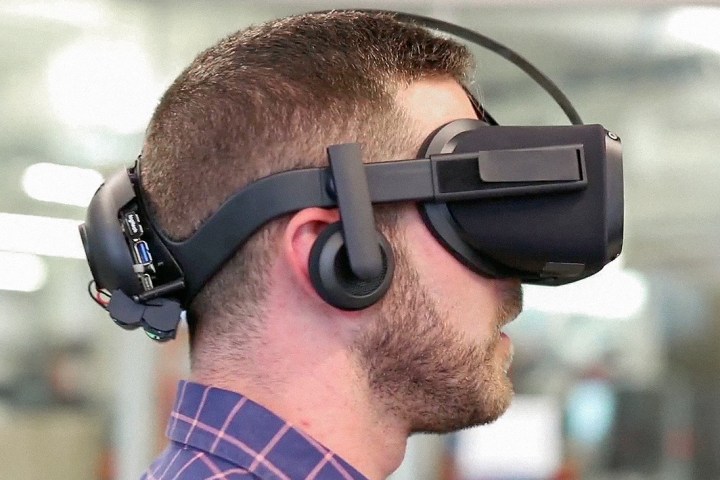
Facebook and Oculus may formally introduce a mid-tier VR headset during the Oculus Connect 5 conference on September 26 and 27. This is an assumption based on a response regarding the “Santa Cruz” headset that sources now claim will arrive in the first quarter of 2019. An Oculus representative wouldn’t comment on the rumor, but instead said “OC5 will be really exciting.”
There’s really no big secret regarding the Santa Cruz headset, except for when it actually hits the market. Oculus confirmed with Digital Trends in March that the headset would serve as a mid-tier product nestled between the high-tier Oculus Rift and the low-tier Oculus Go. It won’t be tethered like the Oculus Rift nor will it be limited to head movements like the Oculus Go.
That said, the Santa Cruz headset will target the stand-alone VR market. It will include built-in cameras to track your physical environment, allowing you to move freely through open space without a tethered PC while remaining in the virtual environment. You also don’t need external sensors — like those used with the Oculus Rift and HTC Vive — to track your physical position in the play space.
Of course, without the wires and external sensors, you’d expect the real world to spoil your virtual fun by throwing walls, furniture and even kids into the mix. Oculus solves this problem with its “guardian” system that throws up a blue grid when you approach a scanned object or wall. Google’s WorldSense technology for its stand-alone Daydream headsets supposedly does something similar.
One of the sessions during the Oculus Connect conference next month will talk about porting Oculus Rift apps to the Santa Cruz headset.
“The introduction of stand-alone means the arrival of more approachable devices and, for developers, a broader range of consumers to target,” the listing states. “The good news is you’re already ready. We’ll start with an overview of the device and basic considerations and walk step by step through the process of reviewing and optimizing textures, scene geometry, and lighting.”
The Oculus Go, launched in May, merely tracks your head movement and incorporates input from a motion controller. The 32GB model costs $200 while the 64GB retails for a higher $250. It supports all VR applications provided through the Oculus Store for Samsung’s Gear VR platform. That said, most of what you purchase for Samsung’s smartphone-based headset will work on the Oculus Go, which doesn’t require a smartphone.
Meanwhile, the Oculus Rift costs $400 and includes the headset, motion controllers, external sensors and so on. It requires a tethered PC and pulls content from the Oculus Store and Steam. That said, we presume the upcoming Santa Cruz headset will have a starting price of $300 for it to fall between the two headsets currently on the market.
The mid-tier Santa Cruz unit is expected to arrive in March 2019 to celebrate the second anniversary of the Oculus Rift’s availability on the market. The original headset arrived on March 28, 2016.
Editors' Recommendations
- Leak reveals how Apple VR headset’s hand tracking may work
- We now know how Apple’s VR headset may handle video, and it’s pretty awesome
- Apple’s VR headset may launch soon, intriguing leak suggests
- Meta wants its next VR headset to replace your laptop
- Apple may have just leaked its VR headset’s operating system


